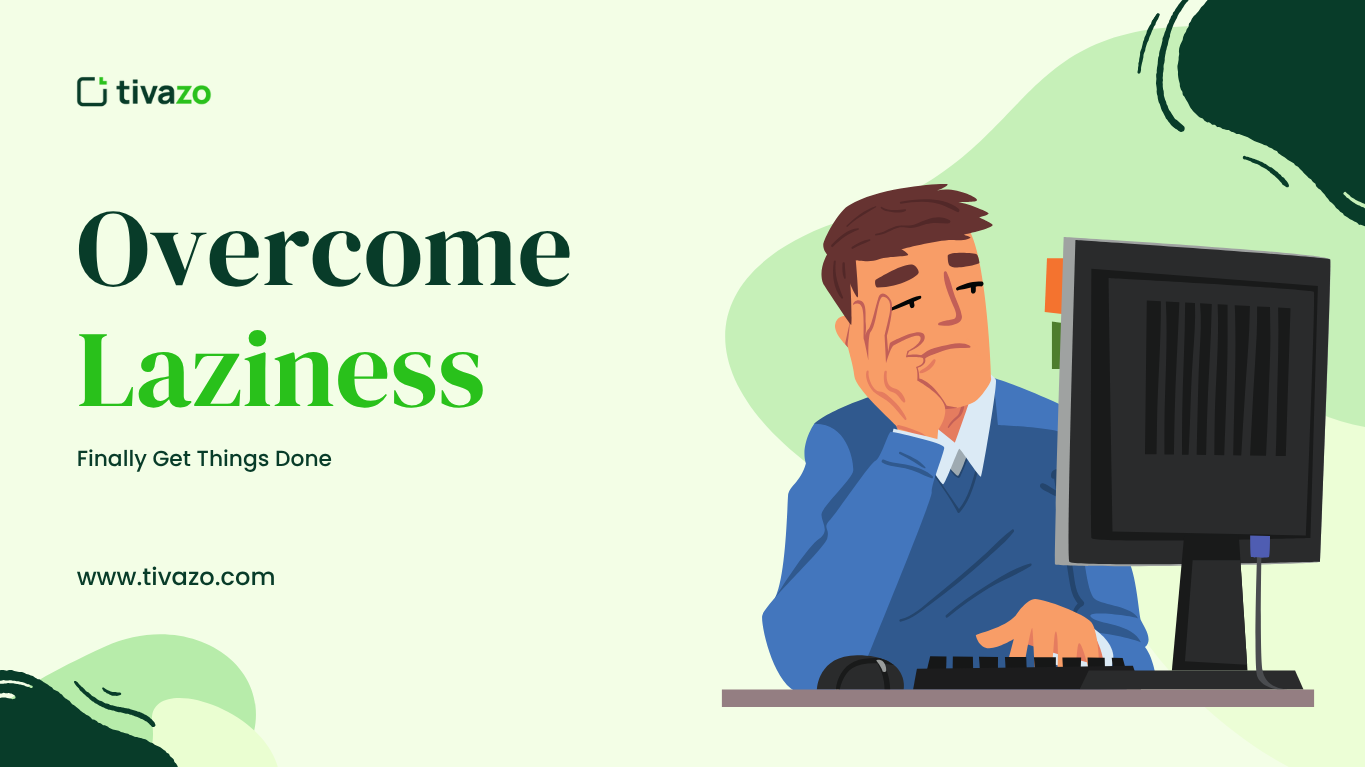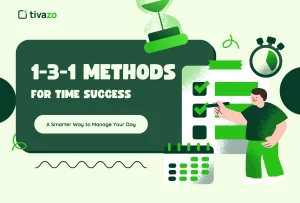You are not lazy — more likely, you are stuck.
If you’ve ever sat down with a clear intention of working only to somehow find yourself spiraling into 45 minutes on Instagram, you are not alone. Laziness is not about not caring — it is about not knowing how to take the leap from intention to action. In this premium guide, you’ll learn how to take courageous and bold fighting action against your laziness, develop an empowered mindset, and create unstoppable momentum.
Whether you are a student overwhelmed with school assignments, a remote worker distracted with an array of other things, or just simply trying to show up for life, this guide is your billion-dollar plan to regain control.
Key Highlights:
- Why Do We Feel Lazy
- 7 Proven Ways to Overcome Laziness
- Psychological Tips to Overcome Laziness
- You’re Not Broken: Lazy vs Burnout Comparison
- Why You Feel Stuck in Life and How to Move Forward
Why Do We Feel Lazy? (Science-Backed Insight)
Let’s debunk this myth: Laziness is rarely a personality defect, and it is usually a symptom of some other bigger issue, like burnout, fear of failing, or exhaustion.
Here are a few common reasons for laziness and lack of focus:
- Executive dysfunction – a disconnect from knowing how to do something and doing it
- Low dopamine levels – reducing motivation and energy
- Decision fatigue – your brain is flat-out overloaded
A tired brain and not a lazy one – physical exhaustion is often confused with apathy
There is a comprehensive difference between a lazy mindset and a tired brain. Awareness of the root cause is the first step to healing it.
The Real Cost of Laziness on Your Life and Goals
Laziness is such an easy habit to rationalize. And it does not feel harmful, but it takes more of a toll on your future than most people ever realize, until it is too late. It comes in the form of small acts: Not going to the gym today, postponing a task, or avoiding that really hard conversation. In the beginning, these were not important events. But over time, these moments turn into something bigger: waiting has chipped away at your self-trust. Each time you delay taking action, your subconscious records it as additional evidence that you are unable, not consistent, or uncommitted.
This then creates more feelings of stress, guilt, and the nagging feeling that you are wasting your potential. Your dreams remain idle, your confidence is lost, and your identity begins to dull. That is an inconspicuous price of waiting; it is not just time lost — it is the slow disconnection from the person you dream of becoming. This is why we need to stop waiting and start doing — not tomorrow, but now, because every action you take is a vote for the person you want to become.
7 Proven Ways to Overcome Laziness
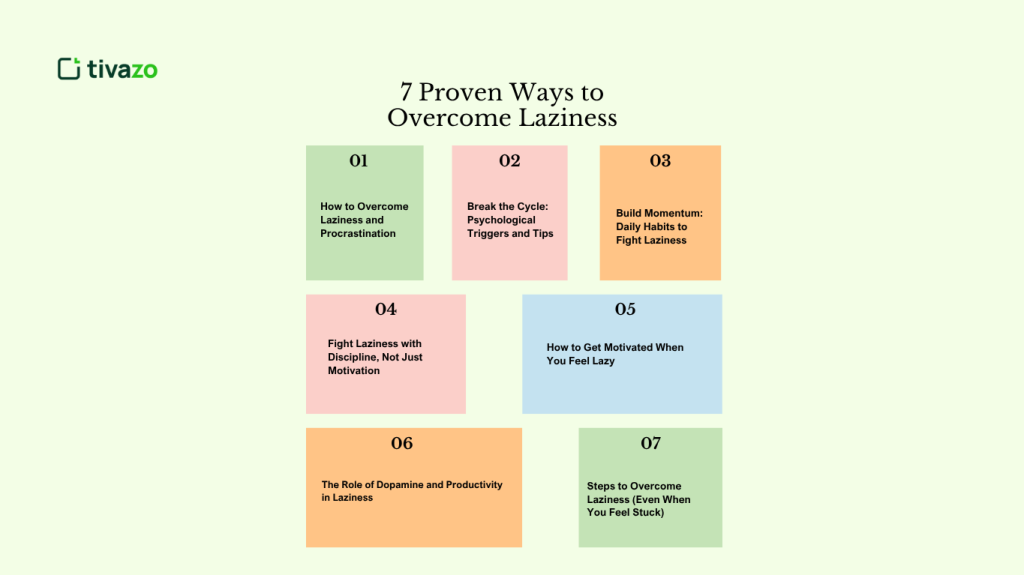
1. How to Overcome Laziness and Procrastination
Laziness, high procrastination, and inaction go hand in hand. You don’t want to do something, so you hesitate and continue to hesitate. This hesitation creates a mental loop: the more you don’t want to do something, the bigger it gets (in size, stress, and fear). However, the reality is that action isn’t the result of motivation; it’s the cause.
You never wait until you’re ready; you get ready by starting. You are not trying to change your life overnight; you are trying to act with consistent momentum in smart, manageable places. You may have wondered, What must I do to stop being lazy? Here’s a helpful map.
- Start with 2-minute tasks – get started by having a low commitment.
- Create friction for distractions – Put blockers in place, take your phone far away from you.
- Use the Pomodoro technique – 25 minutes on; 5 minutes off.
- Set identity-based goals – “I’m the kind of person who is disciplined” > “I’ll try to work harder.”
- Celebrate small wins – Teach your brain to celebrate small wins by creating a mini dopamine hit.
The key to overcoming laziness is not about doing more, but doing smarter.
2. Break the Cycle: Psychological Triggers and Tips
Laziness is usually not a deficit in ability — it is based on some subconscious looping in the mind. For example, many people fail to recognize that their inaction isn’t primarily a matter of laziness, but of psychological fears, perfectionism, and emotional burnout. These can’t just be dismissed as weaknesses. They are signs of overwhelm. To protect itself, the brain has resorted to avoidance. The good news? These loops can be broken.
The first task in breaking these loops is to identify your specific psychological triggers, start to categorize them, and then actively frame or reframe the trigger as much as possible. This will lead you to a resolution and allow you to take a little control back. You are not trying to battle your brain; you just need to understand it.
To help with prioritization of your action steps, bake in these psychological strategies to overcome laziness:
- Visualize completion, not the task
- Name the resistance (e.g., “I’m afraid this will suck”)
- Use self-talk (“I do hard things, even when I don’t feel like it”)
There is self-talk and framing your resistance, and there is re-wiring your narrative and breaking analysis paralysis psychological loops before they have grasped you.
3. Build Momentum: Daily Habits to Overcome Laziness
Laziness isn’t just a lack of willpower. More often, it’s a lack of flow. The human brain craves consistency. If you don’t have rhythm, then every single decision drains energy, and you can only make so many decisions before you drain your battery. However, if your day meets a rhythm, then you get to conserve that energy to do meaningful work. That’s why momentum comes from flow, not motivation. Habits give action automaticity, which means you don’t hesitate to act.
When you plan your day intentionally, when you wake, where you move, and what you focus on, you’d expect the result to be reduced decision fatigue and a place for discipline to flourish. The trick isn’t to do more. It’s to design your day so well that laziness has no chance.
4. Overcome Laziness with Discipline, Not Just Motivation
Motivation is ephemeral. Discipline is designed. You can’t depend on motivation to show up every time, because it doesn’t. There will be days when you wake up tired, overwhelmed, or just never inspired. That’s where discipline comes in. One of the best ways to build discipline is through if/then planning. For example: “If I wake up late, then I still commit to doing my top task.” This creates a backup plan, meaning failure never equals quit. You also need to make “failure” less convenient than success.
This could mean working in public places where it is harder to be distracted, or adding accountability by simply telling someone your goal. Finally, celebrate every little success by continuously keeping a “done list” – a written record of your completed items that illustrates you continue to move forward.
Discipline is not being mean to yourself. It is establishing smart systems that deliver results even when you are not feeling it. And that is the difference between those who wish and those who win.
5. How to Get Motivated When You Feel Lazy
Just because you feel lazy doesn’t mean you are lazy; it just means your brain needs to hit the reset button. One of the quickest ways to activate motivation is to do something physical! A short walk or stretch can stimulate your energy and focus. You may also want to change your space (different room, lighting, music, etc.) in order to disrupt your inertia.
You can also go back to your “why” or vision statement to remind you of the overall purpose of your action and invigorate that motivation.
If you had trouble focusing, see if you can eliminate your distractions that are taking your attention, and replace them with the things that are inspiring and supportive of your goal. Self-motivation is not something to wait for; it is something to create out of purposeful action, specifically small action.
6. The Role of Dopamine and Productivity in Laziness
Your motivation is largely linked to your brain’s dopamine levels – when you have low dopamine, you are going to have lower drive and lower energy, leading to a poorer start. You can increase dopamine naturally by consuming protein-rich foods – after all, protein provides the building materials for making dopamine. You can also eliminate overstimulating strategies like continuously multitasking or screen time, as these things can really diminish dopamine.
Exercising without exerting too much effort, like taking cold showers or brisk walks, will begin to release dopamine and will also help with focus. Once you understand how dopamine and productivity interact, you can start to employ smarter work strategies that enhance your brain chemistry for productivity rather than purely relying on willpower.
7. Steps to Overcome Laziness (Even When You Feel Stuck)
Movement is possible even if we feel completely stuck, and it only starts with little, manageable steps. First, simply choose one thing you want to accomplish during our work together. This clarity helps minimize the feeling of overwhelm and allows your brain to focus. Next, you will break that task down into smaller, more approachable steps so that it feels less daunting. Then you will commit to only doing the first step, without any pressure to complete everything. Sometimes you will end at that one step, other times you will push through to finish the task.
This process builds up what I like to call micro-trust. Each small action you take builds your belief in your ability to follow through. Remember: action creates clarity, not the other way around. Consequently, we need to take imperfect action to move beyond being lazy and get back to building momentum.
Morning Routines That Energize the Mind
The way you begin your morning can shape the rest of your day. A morning routine creates a sense of flow and direction before distractions rush in. If you drink water as soon as you wake up, it will put your body into gear while delaying your phone to avoid stress. If you take five minutes to write about how you want to feel, you will immediately create positivity.
Getting morning sunlight will help boost your dopamine levels and will automatically help your mood and alertness. By reviewing your top two goals for the day, you make every part of your day purposeful. The momentum starts before breakfast; do not leave it to chance.
Psychological Tips to Overcome Laziness
Laziness is generally more about mental barriers rather than willpower. With an understanding of your psychological triggers and how they impact your behavior, you can move beyond the inaction that accompanies laziness. Learning to reframe negative self-talk, visualize an outcome instead of focusing on effort, and utilize affirmations are ways to rewire and retrain your brain’s response to demanding situations, including laziness.
The concepts, or ideas, suggested that go beyond limitations contributing to laziness by changing your internal dialogue for forward motion and lasting change.
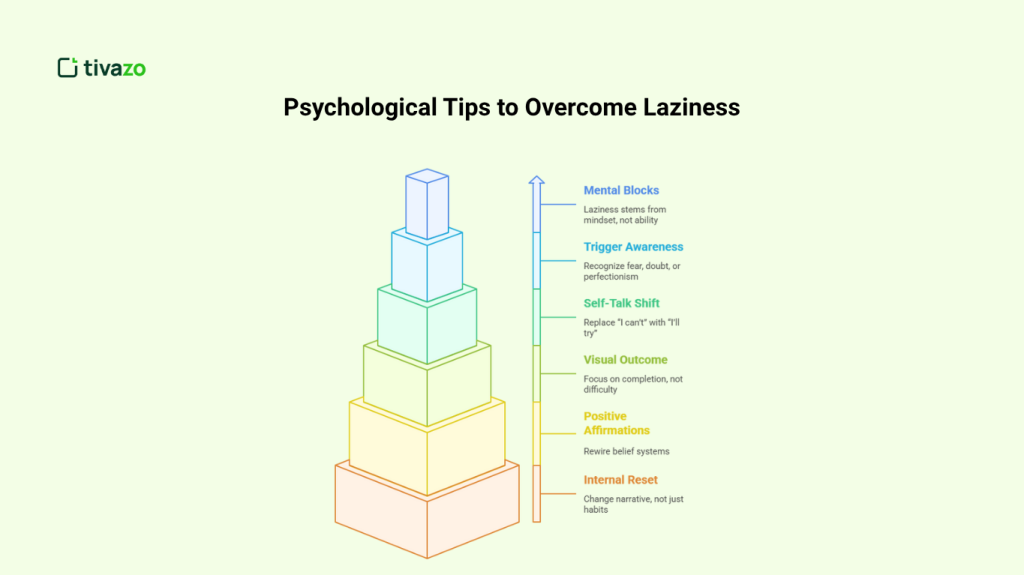
- Mental blocks – Laziness stems from mindset, not ability
- Trigger awareness – Recognize fear, doubt, or perfectionism
- Self-talk shift – Replace “I can’t” with “I’ll try”
- Visual outcome – Focus on completion, not difficulty
- Positive affirmations – Rewire belief systems
- Internal reset – Change narrative, not just habits
How to Overcome Laziness in Students: Practical Strategies
Students encounter barriers in the form of abilities that contribute to lethargy and procrastination. These barriers can occur in tandem and apply to students in a variety of learning environments: student workload, sources of distraction, and indistinct goals. Strategies catered to the source of disengagement and confusion are practical approaches to overcome laziness, or “sloth”.
For example, blocking study sessions into distinct learning modules, defining the priority of assignments/work, and establishing accountability with a colleague all have a positive, active impact on studious behavior.
Active learning strategies, along with physical activity and movement buffers, can extend effort durations for cognitive load and retention. Ultimately, modeling practical strategies for the solution of laziness in students, enabling discipline, relief from neurotic stress, and ultimately improved academic achievements under the umbrella of learning habits.
You’re Not Broken: Lazy vs Burnout Comparison
Many mistake burnout for laziness.
Here’s the difference:
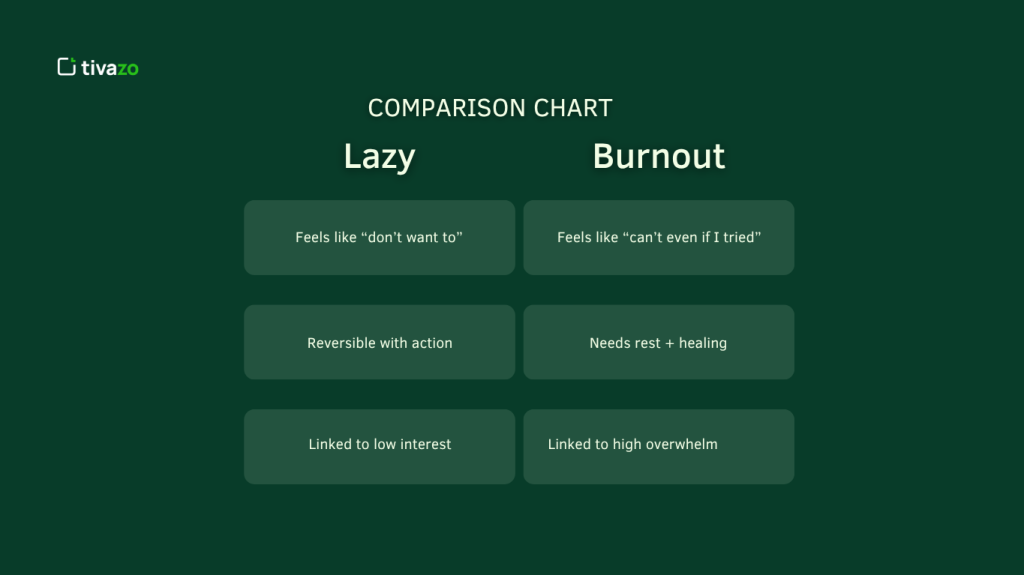
Why You Feel Stuck in Life and How to Move Forward
Feeling stuck often indicates that your mindset or environment is not conducive to your current growth. Emotional blocks such as fear, self-doubt, or shame from past living failures can create invisible barriers to your actions. If you can see these barriers as invisible, reframing them opens up possible pathways forward.
You’ll find various considerations in this section that may describe why you are experiencing feelings of immobilization and ways to take action again, such as setting smaller goals, asking for help, and taking imperfect action. Understanding why you feel stuck in life and how to move forward is the first step on your path to breaking free and reclaiming your drive
Final Thoughts: You’re Not Lazy—You’re Stuck, But Not Broken
You’re not broken. You’re just running a loop. And you can rewrite loops.
You don’t need to work harder. Start working smarter.
To overcome laziness, stop identifying with it. Start experimenting with action. Track your small wins. Build your future. Your best self is already possible—you just have to move towards it.
You have this.
FAQs
How did I cure my laziness?
By creating structure, setting identity-based goals, and taking action even when I didn’t feel motivated.
What is the 3 second rule for laziness?
Act within 3 seconds of having an idea—before your brain talks you out of it. It breaks hesitation and builds momentum.
What is the root cause of laziness?
Mental fatigue, fear of failure, lack of purpose, or low dopamine—often it's not laziness, but overwhelm or burnout in disguise.
Is laziness a mental disorder?
No, but chronic laziness can be linked to conditions like depression, executive dysfunction, or ADHD-related challenges.
